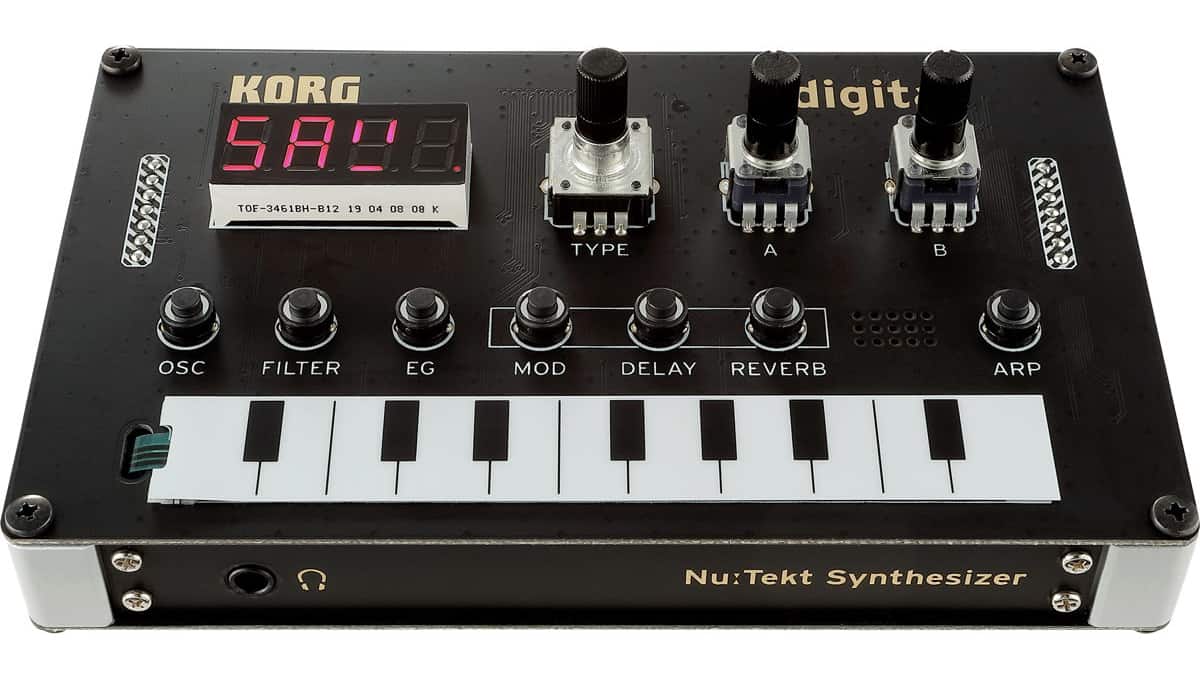Columns
Bat Utility Belt: Korg Nu:Tekt NTS-1 Review


Filter and Effects
The filter section offers lowpass, bandpass, and highpass shapes, all with resonance and 2- or 4-pole slopes. Instead of a filter envelope, you get a ramp that can fade the filter attack up or down. (Hold the FILTER button to adjust the rate and amount.) The filter didn’t burble with personality, but third-party filters are available as modulation effects.
Effects are a high point of the NTS-1. The MOD button calls up chorus, a rich ensemble, phaser, and flanger, all with time and depth controls. Delays include mono, stereo, ping-pong, highpass, and a lovely tape emulation. Changing the time produces trippy, analog-style glitching. Cranking the Depth control (feedback) creates infinite repeats for instant soundscapes.
The maximum delay time is about 650ms; third-party delays include extended loopers. Unfortunately, there’s no tempo sync. At 120 bpm, I got rhythmic echoes by sending CC30 with values of 5, 13, 33, 52, 62, 92, and 122. Reverbs include hall, plate, the appropriately lush Space, and two pitch-shifted effects: the shimmery Riser and gorgeous Submarine.
If you plan to use the NTS-1 as a set-and-forget effects processor, note that it goes to sleep after 15 minutes. That was never an issue for me, because waking it up requires a simple tap on the OSC button.
Update: Firmware update 1.20 lets you disable sleep mode. See the details in my Instagram post.
Arpeggiator, Sync, and MIDI
I found the arpeggiator handy for live jams. The first six buttons set various chords. Holding the ARP button lets you latch playback and adjust the tempo and number of steps. Although the tempo syncs to MIDI and analog sync signals, I wish the NTS-1 would arpeggiate incoming MIDI notes instead of just changing the root of the chord. I was able to add swing by connecting Korg’s SyncKontrol app (see photo).
In the MIDI department, the NTS-1 responds to velocity (amp level), pitch bend, and so many CCs that you could turn a sequencer into a patch librarian (see table). Surprisingly, it ignores the common CC1, CC7, and CC64 (modulation, volume, sustain), so I remapped my keyboard’s mod wheel to control either tremolo (CC21) or waveshape (CC54).
Conclusions
The NTS-1 is essentially a development board for oscillators and effects, but it has enough synthesis features to make it an appealing add-on instrument, and more than enough to be a terrific effects processor. The compact size, MIDI control, ability to run from USB power packs, and stereo input make it easy to integrate into any setup. And the quality and variety of sounds make it a bargain for $99. (Plus, Korg includes a big bundle of soft synths and music software.)
My wish list is small: tempo sync for the delay, a dedicated vibrato LFO, portamento, a full filter envelope, and a few more knobs. When the NTS-1 does hit stores in bulk, Korg will have a hard time keeping it in stock.
Website: Korg.com
Price: $99
Korg Nu:Tekt NTS-1 MIDI Control
| CC | PARAMETER |
| 14 | Amplifier EG Type (ADSR, AHR, AR, AR Loop, Open) |
| 16 | EG Attack |
| 19 | EG Release |
| 20 | Tremolo Rate (marked “depth” in v1.0 MIDI chart) |
| 21 | Tremolo Depth (marked “rate” in v1.0 MIDI chart) |
| 24 | Oscillator LFO Rate |
| 26 | Oscillator LFO Depth (0–61 frequency, 62–65 null, 66–127 waveshape) |
| 28 | Modulation Time |
| 29 | Modulation Depth |
| 30 | Delay Time |
| 31 | Delay Depth (feedback) |
| 33 | Delay Wet/Dry Mix |
| 34 | Reverb Decay Time |
| 35 | Reverb Depth |
| 36 | Reverb Wet/Dry Mix |
| 42 | Filter Type (LP2, LP4, BP2, BP4, HP2, HP4, Off) |
| 43 | Filter Cutoff |
| 44 | Filter Resonance |
| 45 | Filter Sweep Depth (0–61 up, 62–65 null; 66–127 down) |
| 46 | Filter Sweep Rate |
| 53 | Oscillator Type |
| 54 | Oscillator Shape |
| 55 | Oscillator Alt Parameter |
| 88 | Modulation Type |
| 89 | Delay Type |
| 90 | Reverb Type |
| 117 | Arpeggiator Pattern (up, down, up-down, down-up, converge, diverge, converge-diverge, diverge-converge, random, stochastic) |
| 118 | Arpeggiator Interval (octave, major, suspended, augmented, minor, diminished) |
| 119 | Arpeggiator Pattern Length (1–24 notes) |
More Synth and Software Reviews

















